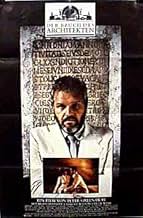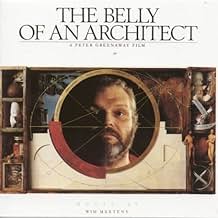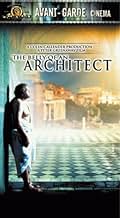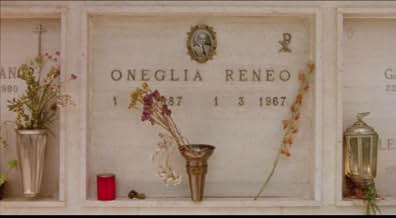NOTE IMDb
6,9/10
6,5 k
MA NOTE
Ajouter une intrigue dans votre langueAn architect supervising an exhibition starts to have mysterious stomach pains while his life slowly falls apart.An architect supervising an exhibition starts to have mysterious stomach pains while his life slowly falls apart.An architect supervising an exhibition starts to have mysterious stomach pains while his life slowly falls apart.
- Réalisation
- Scénario
- Casting principal
- Récompenses
- 2 nominations au total
Marino Masé
- Trettorio
- (as Marino Mase)
Avis à la une
Brian Dennehy and Chloe Webb come to Rome. He's an architect who has been working for ten years on an exhibit about Etienne-Louis Boullee, and it has reached the stage where the physical labor has to be done. As the project moves sluggishly forward, Dennehy can't figure out where the money is going. All he knows is that Roman architect Lambert Wilson is carrying on an affair with Miss Webb, angling to take over the exhibit, and he has new and distressing pains in his gut.
Peter Greenaway directs High Art films that flirt with the limits of watchability -- I've never been able to get past the initial image in PROSPERO'S BOOK, of John Gielgud in hs bath, watered by cherubs like a garden fountain. This one is very watchable, with its bits of color, and Dennehy's solid performance against the wreckage of classical art through the movie's Rome; there's one funny moment when he uses the feet of a colossal sculpture to scratch his back. Yet, in the end, Dennehy's performance takes over the entire movie, leaving everyone else as bit players. Others' motives, except for Lambert's greed, remain obscure. Is Greenaway satirizing the excessive intellectualization of a practical art of which he himself is guilty?
Peter Greenaway directs High Art films that flirt with the limits of watchability -- I've never been able to get past the initial image in PROSPERO'S BOOK, of John Gielgud in hs bath, watered by cherubs like a garden fountain. This one is very watchable, with its bits of color, and Dennehy's solid performance against the wreckage of classical art through the movie's Rome; there's one funny moment when he uses the feet of a colossal sculpture to scratch his back. Yet, in the end, Dennehy's performance takes over the entire movie, leaving everyone else as bit players. Others' motives, except for Lambert's greed, remain obscure. Is Greenaway satirizing the excessive intellectualization of a practical art of which he himself is guilty?
One of my favorite Greenaway films. Story, visuals, metaphor, acting, music...it's got it all. The visuals of Rome are stunning. Wim Mertens' musical accompaniment is brilliant and on par with any modern minimalist composition. After years of seeing his TV roles, I was completely floored by the depth and authenticity Brian Dennehey brought to the main character. I've watched this film at least a dozen times over the years and enjoy it thoroughly each time. Unlike a previous reviewer, I don't see the need to judge this film based on how much it resembles previous or subsequent Greenaway films. "Belly of An Architect" is not as abstract as some of the other Greenaway films, but that shouldn't be viewed as a negative. The film is great and rich in its own right. I highly recommend it.
Greenaway's visuals (which betray his origins as a painter in almost every gorgeously composed shot) are sumptuous. Wim Mertens score is mesmerizing. Add them to Brian Dennehy's towering performance as obsessed, betrayed, and ultimately dying American architect Stourley Kracklite and you have something very special. Kracklite is in Rome battling to put on an exhibition to his idol, 18th century French architect Etienne Louis Boulet. His young wife (Webb) betrays him, the natives scheme to undermine his exhibition and he begins to crumble physically like the ruins of the eternal city around him. The story, largely carried on Dennehy's massive shoulders, is almost incidental to the glorious, poetic footage of Rome. It is so movingly beautiful that, when I finally got around to visiting the city (a trip in no small part inspired by this film) the reality of the place couldn't compete. If you can, watch this on a big screen with the best possible suround-sound. If you can't, watch it anyway.
Starring Brian Dennehy, an unusual actor for a Peter Greenaway film, as Kracklite, an architect, a career we don't often see explored in cinema, Greenaway's 'Belly of an Architect' is somehow bigger and more emotionally ambitious than most of his other works, which lack human resonance. In his other films, the characters are uniformly British and so Greenaway's coldness and archness toward them is indicative of a general misanthropy. Here, it's aimed squarely at Romans, whose loose morals and carnivorous practices contrast with the enormity of Kracklite's ego and generosity of spirit. His stomach is being eaten away by some unknown illness or cancer, and this serves as a metaphor for his ego being eaten away by the carnivorousness of Roman culture. His wife, his identity (which is a vicarious one, given his devotion/debt to his idol, Bouleé) and his work are being repossessed by the conquestful Roman carnivores who aim to destroy him simply for the material gain of taking what is so ostentatiously his. But his devotion to Bouleé, his need to make Bouleé's work more widely known, is not a singular or altruistic act; the exhibition he is organizing will make Bouleé more commercial and accessible, but it will also be an addendum to his own career, a manifestation of his ego. His diary is written in the form of letters to Bouleé, to whom he is almost praying as his own personal God. And his devotion to this God is not a selfless one, since Bouleé is so inexorably an element of his own identity.
Rome and its buildings are given a golden, postmodern glow, their clarity enhanced by Wim Mertens' musical score, which adds its own sunlight to the proceedings. But the sunlight that glows throughout Rome and permeates the aura of the film is an impersonal one, an indifferent one, as ancient as the ruins of Rome, which our Roman characters observe have been more useful and influential as ruins than they were prior. "They're better as ruines," a character observes. "Your imagination compensates for what you don't see, like a woman with clothes on." The Romans are depicted here as carnivores (and the word "carnivore" is used multiple times) who not only want to devour and repossess, but want to strip. Brian Dennehy's performance here is indeed stripped, larger than life, fiery. He explodes on screen, bringing the film into another realm, introducing emotional dimensions not often seen in the films of Greenaway; and in this, the film has a power that inhabits the movie's symmetrical form (mostly every shot is symmetrical), its architecture, and threatens to destroy it. The coldness that is typical of Greenaway, that architecturized godlessness, is at war with fiery human passion in all its flawed nakedness.
Greenaway's movies, in their arctic wit and obsession with symmetry, are cinema as architecture more so than storytelling, so 'The Belly of an Architect,' contrary to the claim by many that it's his most mainstream and therefore weakest work, is perhaps his most appropriate film, and maybe his best
Rome and its buildings are given a golden, postmodern glow, their clarity enhanced by Wim Mertens' musical score, which adds its own sunlight to the proceedings. But the sunlight that glows throughout Rome and permeates the aura of the film is an impersonal one, an indifferent one, as ancient as the ruins of Rome, which our Roman characters observe have been more useful and influential as ruins than they were prior. "They're better as ruines," a character observes. "Your imagination compensates for what you don't see, like a woman with clothes on." The Romans are depicted here as carnivores (and the word "carnivore" is used multiple times) who not only want to devour and repossess, but want to strip. Brian Dennehy's performance here is indeed stripped, larger than life, fiery. He explodes on screen, bringing the film into another realm, introducing emotional dimensions not often seen in the films of Greenaway; and in this, the film has a power that inhabits the movie's symmetrical form (mostly every shot is symmetrical), its architecture, and threatens to destroy it. The coldness that is typical of Greenaway, that architecturized godlessness, is at war with fiery human passion in all its flawed nakedness.
Greenaway's movies, in their arctic wit and obsession with symmetry, are cinema as architecture more so than storytelling, so 'The Belly of an Architect,' contrary to the claim by many that it's his most mainstream and therefore weakest work, is perhaps his most appropriate film, and maybe his best
The ebullient Brian Dennehy gives a fine performance as Stourley Kracklite, an American architect who is in Rome with his younger wife Louisa (Chloe Webb) to arrange an exhibition on the French architect Etienne-Louis Boullée. Kracklite is obsessed with Boullée and even writes letters to him. Kracklite's life soon begins to deteriorate. He starts to suffer excruciating stomach pains and vomits each time he eats. He even thinks that his wife is poisoning him. His wife then falls pregnant and has an affair with Kracklite's rival architect, Caspasian Speckler (Lambert Wilson). Kracklite then sleeps with Speckler's sister, to get some sort of satisfaction. Speckler intrudes while they are having sex, and announces, "having sex with your pregnant wife is perfect, because I don't need to use contraception". Kracklite then punches him on the nose. Speckler's sister then says, "Don't put your blood on my white towel."
The film follows the parallels of these two unappreciated architects from different eras. The film is memorable for Dennehy's (an actor who is also unappreciated) remarkable performance. Also, the beautiful cinematography by Greenaway's trusty DOP Sacha Vierny makes the film very easy to look at. From the ancient architecture of Rome, to a painting-like bowl of figs, it is pristine-looking. Michael Nyman is absent, but the music by Wim Mertens is splendid. This film was made in between A Zed & Two Noughts and Drowning by Numbers, and it is quite unlike those two films, which, I think, are superior to this in the way they offer us a much more enigmatic, abstract concept. But even an ever so slightly lesser Greenaway film is a thing to behold.
The film follows the parallels of these two unappreciated architects from different eras. The film is memorable for Dennehy's (an actor who is also unappreciated) remarkable performance. Also, the beautiful cinematography by Greenaway's trusty DOP Sacha Vierny makes the film very easy to look at. From the ancient architecture of Rome, to a painting-like bowl of figs, it is pristine-looking. Michael Nyman is absent, but the music by Wim Mertens is splendid. This film was made in between A Zed & Two Noughts and Drowning by Numbers, and it is quite unlike those two films, which, I think, are superior to this in the way they offer us a much more enigmatic, abstract concept. But even an ever so slightly lesser Greenaway film is a thing to behold.
Le saviez-vous
- AnecdotesBrian Dennehy was quoted after the release as saying "I've made lots of movies but only one film."
- GaffesWhen photocopying the picture of Augustus, Kracklite puts the picture in upside down which would have given a blank copy (unless the same picture was on both sides). Additionally, it would not be possible to achieve the level of resolution of Augustus' abdomen from such a small picture.
- Citations
Caspasian Speckler: Your wife is very beautiful, Signor Kracklite, especially when she is pregnant.
Stourley Kracklite: Yes, that's right. She is pregnant. But not with your child, Speckler.
Caspasian Speckler: True. I'm very grateful to you for that. Your child, shall we say, is the most perfect contraceptive.
[Kracklite turns and punches Speckler in the nose]
- ConnexionsFeatured in Peter Greenaway (1992)
Meilleurs choix
Connectez-vous pour évaluer et suivre la liste de favoris afin de recevoir des recommandations personnalisées
- How long is The Belly of an Architect?Alimenté par Alexa
Détails
- Date de sortie
- Pays d’origine
- Langues
- Aussi connu sous le nom de
- The Belly of an Architect
- Lieux de tournage
- Sociétés de production
- Voir plus de crédits d'entreprise sur IMDbPro
Box-office
- Montant brut aux États-Unis et au Canada
- 287 725 $US
- Durée1 heure 59 minutes
- Couleur
- Mixage
- Rapport de forme
- 1.85 : 1
Contribuer à cette page
Suggérer une modification ou ajouter du contenu manquant

Lacune principale
By what name was Le Ventre de l'architecte (1987) officially released in India in English?
Répondre






























